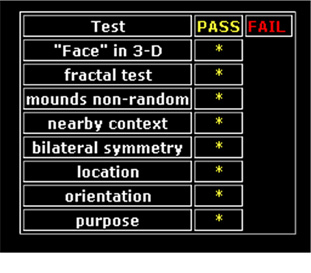One day in 1996, I was attending college in San Diego, California, when someone tangentially mentioned to me that there was a ‘face’ and ‘pyramids’ on the surface of Mars. And that NASA had taken photographs of these objects.
I was of course very skeptical to this information and did not think much of it. If NASA had taken pictures of artificial structures on the surface of another planet, this would be the biggest discovery of our lifetime. This was the first time I had heard of Cydonia, the region of Mars where the face and pyramids are located. And since I have never seen this topic covered on MSNBC or CNN, I assumed it must be ludicrous.
When I looked at the photos of the Face and Pyramids on Mars, they seemed very familiar to something I had seen here on earth. The sphinx and pyramids in Egypt. I had just started to learn how to use the internet in 1996, so I began to curiously look into what NASA and other sub-contracted agencies of NASA were currently studying. It turns out the principal scientist in charge of the cameras we attach to the orbiters we send to mars are controlled by a company also located in San Diego, California, Malin Space Science Systems.
I contacted Dr. Malin to ask him about the Face and Pyramids on Mars and he was nice enough to respond to me directly. He stated ‘there is no evidence that the face and pyramids are artificial structures. We simply attribute them to sand and natural weather erosion.’ This answer really intrigued me because when I looked at the Cydonia region of Mars, the face, pyramids, and even other surrounding objects were clearly formed in some ‘artificial’ way.
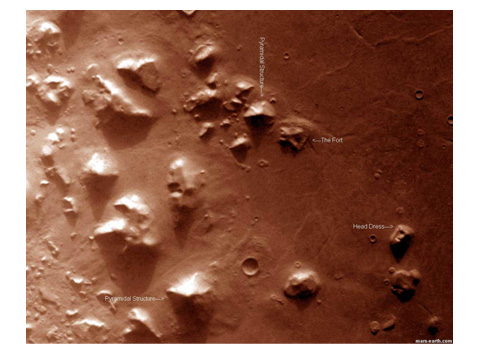
I began to look for answers outside of NASA to see if others were aware of these photographs and if any proper science had been done to explore if these could possibly be artificial structures. I was able to find 5-10 peer level review scientists that have PhD’s in image analysis of satellite telemetry. People who did not work for NASA, but had the same level of education and experience. One of these people is Dr. Mark Carlotto, who used mathematical algorithms to detect Russian military troops and artillery from satellite telemetry over Russia. Running these algorithms on Russian satellite telemetry showed objects hidden by tarps or bushes still had a high probability of being artificial. Dr. Carlotto used these same mathematical algorithms on the satellite telemetry from the surface of Mars and found the Face and Pyramids to be over 98% probability of being artificial.
NASA never applied any level of scientific scrutiny to these structures and just quickly tried to say these objects were just a trick of light and shadow. However, we found that statement to be erroneous.
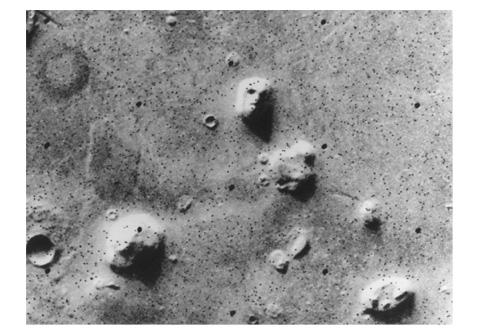
The first image NASA took of the Face On Mars was back in the 70’s from their Viking Orbiter. When the image was beamed back to NASA headquarters, they quickly labeled the shot ‘Head’ and said that they re-imaged the same location several hours later and the face was gone. WRONG ANSWER NASA!
It turns out that NASA had taken several images of the ‘head’ from different orbital latitudes where the degree of the camera and the angle of the sun was different. And each time the face still is visible. It’s a 3dimensional model carved in stone! Notice the shadow on the face in the below images is different in each image, but it still looks like a face.
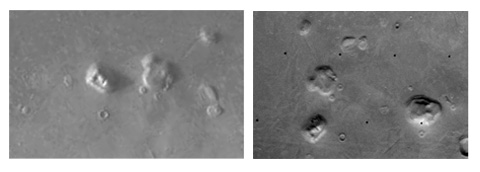
These images were located in the 80’s by 2 researchers named Vincent Dipettrio, and Greg Molenar. They did further study to show that the large pyramidal structure near the face was expressing high level geometry to other structures in the area. This was also confirmed by several other independent researchers.
I become very fascinated with the face and wanted to know for myself weather this structure was man made. I downloaded every high-res image of the face I could get from NASA going back to the 70’s Viking missions.
In looking at the face closely under magnification on a computer, I started to notice actual facial characteristics that I could recognize such as a nose, eyes, teeth, and even a head dress of some sort that could be a helmet or head ornament.
I started to ask myself ‘How could this be?, Why is it that not one of my friends or anyone I know is aware of this!’
It seemed the face was very badly eroded on the right side, but the left side still had very clear facial features. Knowing that all faces are A-symmetrical, I decided to run a few tests on the face.
When you look at your face in a mirror, only exposing half your face, you still see your face in the mirror. The reflected side of your face matches the part not shown in the mirror. This same practice used on the face on mars brings out some interesting details.
There are several images of the Face that NASA has taken in the past 30 years. I choose some of the more recent images shot in the 90’s for this test. Interesting to note that the Face actually looks worse in more recent images. You would think that with improved camera technology, NASA would be able to produce clearer images of the face. For some reason the clearest images of the face are from the 70’s. Is NASA trying to hide something?

Back to the test….Taking the image you see here and mirroring the ‘left’ and ‘right’ side of the image produces some interesting results.
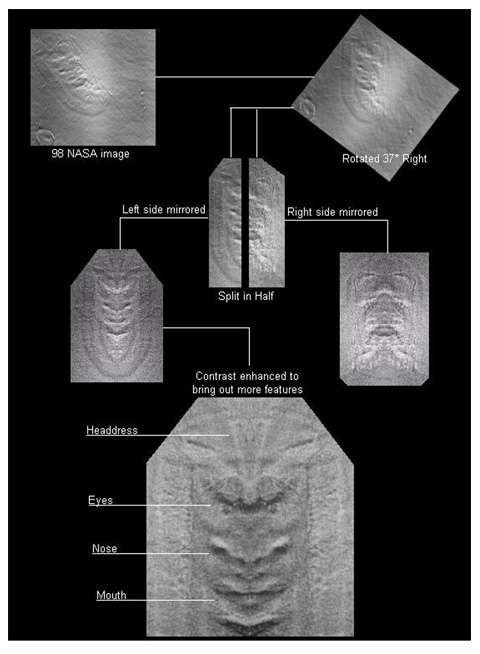
Looking at the right side which is using the more eroded right part, you can still see clear facial characteristics like eyes, nose, mouth, and overall semitry in its appearance. Now look at the mirrored left half which is not as eroded and shows much clearer features. Now we begin to see the real detail. Even the outer lining of the head seems to have a strong resemblance to a head dress.
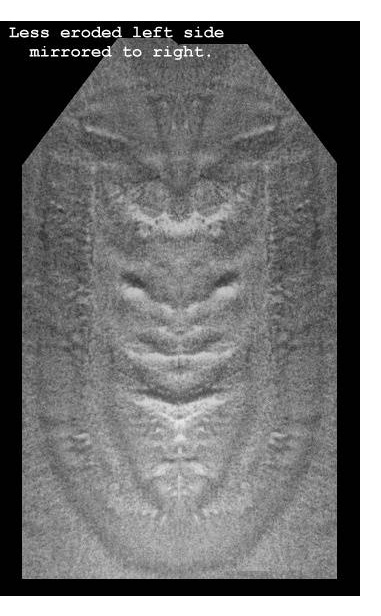
The ‘Face’ on Mars has now passed each test of artificiality yet proposed. These tests include a three dimensional structure, a lack of fractal patterns in the image, non-random distribution of the nearby small mounds, proximity of other anomalous landforms, an apparent bilateral symmetry, being located on the martian equator, having a culturally significant orientation, and serving an apparent culturally significant purpose.
